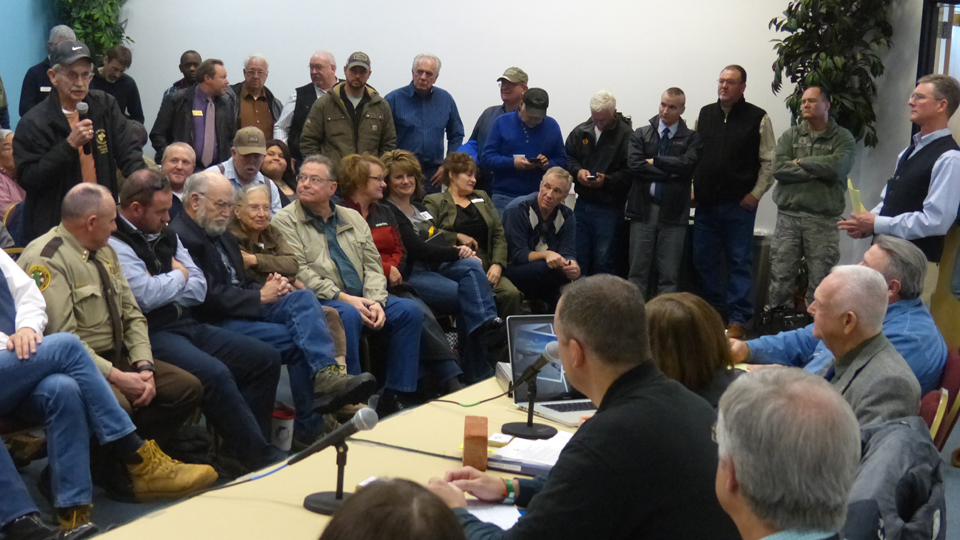
 Gov. Kate Brown and other state and local officials listen to local concerns about storm damage during a town hall meeting in Ontario on Friday, Feb. 10, 2017. (Malheur Enterprise/Les Zaitz)
Gov. Kate Brown and other state and local officials listen to local concerns about storm damage during a town hall meeting in Ontario on Friday, Feb. 10, 2017. (Malheur Enterprise/Les Zaitz)No doubt Gov. Kate Brown went home to Salem last week with her ears ringing from pleas for help in Malheur County. Now, we’ll see what the governor, state agencies and the Legislature can do to give meaningful aid to recover.
What’s not going to show up: state bureaucrats carrying blank checks. The governor and her staff made clear that the state of Oregon has no special kitty tucked away for disaster relief. Businesses, property owners and local governments can’t anticipate they will be made whole by the state from losses, whether a crushed building, lost sales, or unexpected labor costs.
At the moment, the best hope for financial help seems to be a constellation of federal programs. But this isn’t free money. Much of the help comes in the form of lending money at low rates. That might save borrowing costs, but the money still has to be repaid. The scope and effect of such federal programs won’t come into focus soon, as the process for getting that help from Uncle Sam isn’t quick.
But Malheur County can benefit from some help that doesn’t require handing out checks.
The onion industry made clear the monumental challenge it faces at the moment: What to do with up to 100 million pounds of spoiled onions. By law, the onions are supposed to be turned under by March 15. The state already flexed, pushing the deadline back to April 15.
Even the additional month, though, doesn’t resolve where to put all those onions. Fields are still buried in snow and the county landfill so far isn’t in a position to take them. One possibility is an outlet in Idaho that might take the spoils. Imagine, though, the number of trucks it’s going to take to haul the mess. The state should be looking for creative – and immediate – options.
More alarming for Malheur County is a message that got out during the governor’s Town Hall. Those in the ag business face the choice of rebuilding where they are here in Malheur County – or jumping the river to Idaho. Let’s be clear. Malheur County can’t afford to lose a single business, a single job.
Clearing the red tape to allow fast construction is going to be essential. That doesn’t mean cutting corners on design or allowing substandard buildings to go up. It means quick decisions on land-use issues, on permits, and on inspections. Every resource the state and county have should be turned to that task: Getting these buildings up in time to rescue the county’s ag sector.
The agriculture community can help itself by quickly identifying the roadblocks to such speed. The more clearly the obstacles are defined, the easier it should be for Brown and her staff to make good on their commitment to do what they can to help. Legislators, too, should be alert to what remedies could be legislated to modify laws or rules that impede but don’t improve reconstruction.
Our county faces months of hard work to clean up, stand up, and move on. The governor heard the message of the imperative of acting – now. She can act with speed when she wants, for instance pushing the state to relax landfill restrictions. She needs to be sure her vow to support rural Oregon is matched by decisions that will save our community jobs, business – and a future. – LZ




